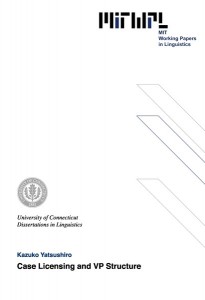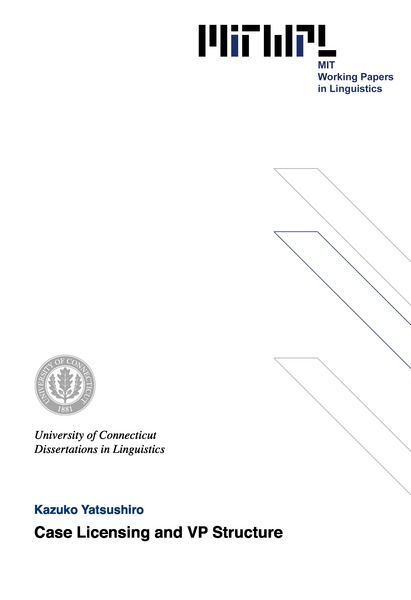Case Licensing and VP Structure
K. Yatsushiro, 1999
In this thesis, I investigate where the Nominative Case of a DP is licensed in Japanese. It has been argued that Nominative Case is licensed only in the Spec of functional projections, such as TP/AgrP (Koizumi 1995). I argue that Nominative Case can be licensed by certain kinds of verbs/affixes within their local domain in Japanese. I propose that Case licensing takes place when a DP and a Case-licenser are in a local relation, such as Spec-Head or Head-Complement. I use the binding and scope relations, and VP-preposing to show the structural relation between Nominative phrase and another element in a structure, and what kind of structural position the Nominative phrase occupies.
In Chapter 2, I argue that Nominative Case is licensed by the unaccusative verbs in Japanese. The evidence for this claim comes from the scope relation between the Nominative and Locative phrases in the unaccusative and passive constructions. The difference between these constructions leads us to conclude that the Nominative phrase in the passive construction raises overtly over the Locative phrase, whereas that in the unaccusative construction does not.
In Chapter 3, I argue that Nominative Case of an object is licensed by the stative verbs/affixes (Kuno 1973). The evidence comes from the VP-preposing construction and the scope relation between the subject and the object.
In Chapter 4, I show that subjects of unergative and transitive verbs raise to the Spec of TP overtly. I further propose that there is only one position for the subject oriented depictive secondary predicate.
In Chapter 5, I discuss the structure within VP in Japanese, arguing that there is evidence for the Split-VP hypothesis proposed by Koizumi (1995), Lasnik (1995), Bobaljik (1996) among others. I also give additional evidence for a classic claim that the indirect objects are always base-generated higher than the direct objects, using the VP-preposing construction.
In Chapter 6, I show that there is covert raising of the Nominative phrase of the unaccusative construction in Japanese. I argue that this is due to the weak EPP feature in T in Japanese.
Chapter 1: Introduction 1
Chapter 2: Nominative Case Licensing 5
2.1. Introduction: How do you assign Nominative Case? 5
2.2. Unaccusative Hypothesis 10
2.2.1. Scope facts in Japanese 16
2.2.1.1. Scope Relation of Quantificational Phrases
in Japanese 17
2.2.1.2. Where is the Locative Phrase? 22
2.2.1.3. Unaccusative vs. passive Constructions 29
2.2.1.3.1. Kuno (1973): Existential
Construction 30
2.2.1.3.2. Unaccusative Construction
and Quantifier Scope 32
2.2.1.3.3. Passive Construction 36
2.2.2. Proposal: Case licensing within VP 40
2.2.2.1. Passives vs. Unaccusatives 40
2.2.2.2. Belletti (1988) 48
2.2.2.3. Lasnik (1992, 1995) 55
2.2.2.4. Unified analysis of Japanese and English
Passives 59
2.2.2.5. Partitive vs. Nominative Case in the
Unaccusative construction 64
2.2.3. Remaining Question: Optional >Partitive vs. Obligatory
Nominative 67
2.3. Summary 71
Appendix: Non-uniform behavior of Quantifiers 72
Chapter 3: Case of Nominative Object 80
3.1. Introduction 80
3.2. Previous Analyses 83
3.2.1. Tada (1992) 83
3.2.2. Koizumi (1995, 1998) 88
3.3. Proposal 92
3.3.1. Relative Scope of Subject and Nominative Object 92
3.3.2. VP-preposing 94
3.3.3. Preliminary proposal 96
3.3.4. Complex Predicate construction in Japanese 98
3.3.5. Koizumis example revisited 100
3.3.6. Revised Analysis 104
3.3.7. VP-sae Construction 106
3.4. Conclusion 108
Chapter 4: Raising for Case 109
4.1. Introduction 109
4.2. Secondary Predicate Construction 110
4.2.1. Koizumi (1994) 110
4.2.1.1. Position of ODP 111
4.2.1.1.1. NQ-float 112
4.2.1.1.2. VP-preposing 114
4.2.1.1.3. Pseudo-cleft Construction 115
4.2.1.1.4. Soo-su do-so Replacement 116
4.2.1.1.5. Summary of ODP 117
4.2.1.2. Evidence for V-adjoined SDP 118
4.2.1.3. Evidence for I-adjoined Subject-oriented
Secondary Predicate 120
4.2.1.4. Questions with Koizumi (1994) 121
4.2.2. Proposal 124
4.2.2.1. Accounting for Koizumis Data 128
4.2.3. Subjects of Unergatives 130
4.2.4. Floating Quantifier and Secondary Predicate 135
4.3. Summary 139
Chapter 5: Structure within VP and Scrambling 140
5.1. Introduction 140
5.2. Evidence for the Movement Hypothesis 143
5.2.1. Chain Condition 144
5.2.1.1. Evidence for the Base-Generation
Hypothesis 146
5.2.1.2. Problems with the Base-Generation
Hypothesis 148
5.2.1.3. Theoretical Problem: Complex Structure
of Reciprocal Anaphor 152
5.2.1.4. Alternative Analysis 155
5.2.1.5. Chain Condition with reflexive anaphor:
karezisin himself 161
5.2.2. VP-preposing construction 163
5.2.2.1. Data 164
5.2.2.2. Previous analyses 169
5.2.2.2.1. Hasegawa (1990) 169
5.2.2.2.2. Inagaki (1993) 175
5.2.2.3. Ditransitives 177
5.2.2.3.1. Data 177
5.2.2.3.2. Analysis 181
5.2.2.3.3. Possible Objection 183
5.2.2.4. Deriving the Proper Binding Condition 185
5.2.2.4.1. VP Topicalization in German 185
5.2.2.4.2. Japanese VP-preposing vs.
German VP-Topicalization 190
5.3. Conclusions 196
Chapter 6: Covert EPP 198
6.1. Introduction 198
6.2. Anaphor Binding 198
6.2.1. Some facts about otagai binding 198
6.2.2. Binding in the Unaccusative and Passive Constructions 201
6.3. Analysis 205
6.3.1. Evidence for movement 208
6.3.2. Why raises covertly? 214
6.3.3. Null-expletive approach 207
6.3.4. Overtly Empty Spec of TP 226
6.4. Conclusion 228
Bibliography 230

